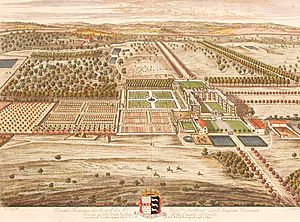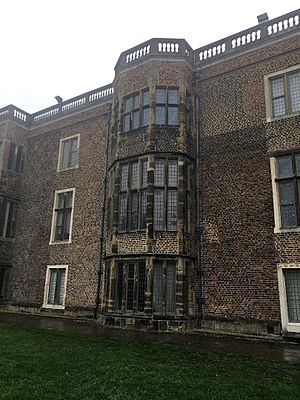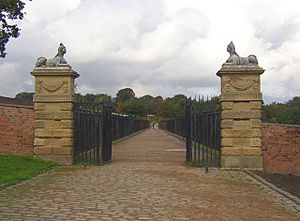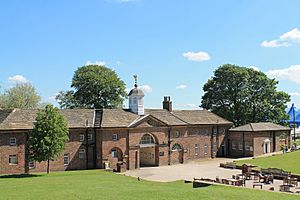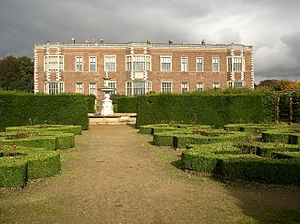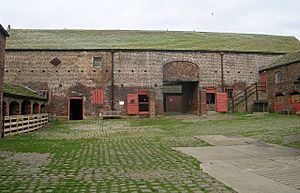Temple Newsam facts for kids
Quick facts for kids Temple Newsam House |
|
|---|---|
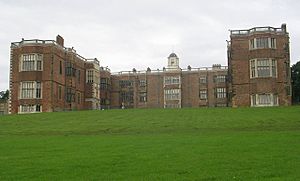
Temple Newsam House – front view
|
|
| Type | English Country House |
| Location | Temple Newsam, Leeds |
| OS grid reference | SE357322 |
| Area | West Yorkshire, England |
| Built | 1500–1520 |
| Architectural style(s) | Tudor-Jacobean |
| Governing body | Leeds Museums and Galleries |
|
Listed Building – Grade I
|
|
| Official name: Temple Newsam House | |
| Designated | 18 October 1951 |
| Reference no. | 1255943 |
Temple Newsam is a grand old house in Leeds, West Yorkshire, England. It was built in the Tudor and Jacobean periods. The beautiful gardens around it were designed by a famous landscape architect named Capability Brown.
Today, Temple Newsam is a Grade I listed building, which means it's very important historically. It's one of eight places managed by Leeds Museums and Galleries. The area around the house is even named after it, called the Temple Newsam ward. You can find it east of Leeds city, near places like Halton and Whitkirk.
Contents
A Look Back: Temple Newsam's History
Early Days: From 1066 to 1520
In 1086, the Domesday Book mentioned this area as Neuhusam, meaning "new houses." It was owned by a powerful family, the de Lacys. Before the Norman Conquest in 1066, it belonged to Anglo-Saxon lords.
Around 1155, Henry de Lacy gave the land to the Knights Templar. These were a group of warrior monks. They built a special building called the Temple Newsam Preceptory nearby. The Templars were very good at farming, raising many animals.
In 1307, the Knights Templar were disbanded. The land then passed through several hands. It was owned by Sir Robert Holland, then Mary de St Pol, and later the Darcy family. In 1488, Thomas Darcy, 1st Baron Darcy de Darcy inherited it. Between 1500 and 1520, the grand Temple Newsam House was built.
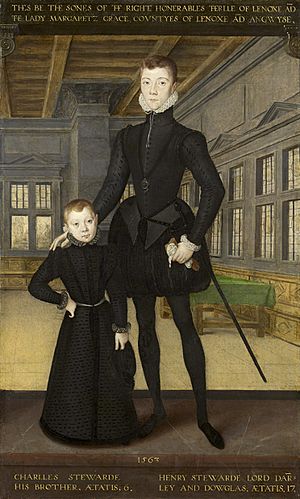
Royal Connections: 1500 to 1650
In 1537, Thomas, Lord Darcy, was executed for his part in a rebellion called the Pilgrimage of Grace. The King took over his property. In 1544, Henry VIII gave Temple Newsam to his niece, Lady Margaret Douglas. She lived there with her husband.
Their son, Henry Stuart, Lord Darnley, was born in the house in 1545. He later married Mary, Queen of Scots, and they became the parents of King James VI of Scotland and I of England. After Henry and Mary married in 1565, Queen Elizabeth I took control of Temple Newsam.
In 1609, King James I gave the estate to his cousin, Ludovic Stewart, 2nd Duke of Lennox. Ludovic was a favorite of the King. He owned many lands, including coalmines nearby. However, he was always in debt. In 1622, he sold Temple Newsam to Sir Arthur Ingram.
Sir Arthur Ingram was a wealthy merchant and investor. Over the next 20 years, he rebuilt much of the mansion. He kept parts of the old house in the west wing. The north and south wings were rebuilt, and the east wing was taken down after a big fire in 1635. Arthur's son, also named Arthur, continued the building work.
New Owners and Changes: 1650 to 1900
After Arthur the younger's son died, Temple Newsam went to Arthur's second son, Henry Ingram, 1st Viscount of Irvine. In 1661, Henry married Lady Essex Montagu. The estate then passed down through Henry's family for many years.
The 4th Viscount brought back many paintings from his travels in Europe between 1704 and 1707. Records from 1692 show that both women and men worked on the estate, for example, in haymaking. In 1712, a new way to approach the house was designed, with a bridge and ponds.
Between 1738 and 1746, Henry Ingram, 7th Viscount of Irvine, updated the west and north wings. He added new bedrooms and a picture gallery. In the 1760s, Charles Ingram, 9th Viscount of Irvine, hired Capability Brown to redesign the park. Charles's wife, Frances Shepheard, was very interested in garden design. She even had a portrait painted of her as a shepherdess!
After Charles died in 1778, Frances rebuilt the south wing in 1796. She lived at Temple Newsam until she passed away in 1807.
Charles and Frances's daughter, Isabella Seymour-Conway, Marchioness of Hertford, inherited Temple Newsam. She was a close friend of the Prince of Wales (who later became King George IV). In 1806, the Prince visited Temple Newsam. He gave Isabella beautiful Chinese wallpaper, which she put up around 1820. She even added cut-out birds from a famous book, The Birds of America.
Isabella was very involved in helping local people. She gave out food and clothing. She also let the servants have an annual supper and ball at the house. During her later years, canals, railways, and roads were built near the estate, along with coal mining. She worked with the companies building these projects.
In 1820, the writer Sir Walter Scott wrote a book called Ivanhoe. It featured a Templar building called Temple Stowe, which many believe was based on Temple Newsam. When Isabella died in 1834, Temple Newsam went to her sister, Frances Ingram Shepheard.
In 1841, Hugo Charles Meynell Ingram inherited the estate. In 1868, the Prince of Wales (who would become King Edward VII) stayed at Temple Newsam. He was visiting Leeds to open an art exhibition. Later, Hugo Charles's wife, Emily Meynell-Ingram, inherited the estate. Emily made many changes, including updating windows and remodeling rooms like the dining room and the great staircase.
The 20th Century and Beyond
In 1909, Leeds Corporation bought a large part of the estate to build a sewage plant. During the First World War (1914–1917), the south wing of the house became a hospital. Edward Wood and his wife Dorothy helped run it.
In 1922, Edward Wood sold the park and house to Leeds Corporation for a very small amount of money. He made sure that the land would be protected for the future. On October 19, 1923, Temple Newsam opened to the public, along with a golf course. People compared it to Hampton Court Palace!
In July 1932, the Great Yorkshire Show was held at Temple Newsam and was a big success. When World War II began in September 1939, Temple Newsam closed to the public. Artworks from Leeds Art Gallery were moved there for safekeeping. However, it soon reopened, displaying the stored items.
Temple Newsam's Architecture
When the new house was built, parts of the old 16th-century house were kept. This included brickwork and bay windows on the west side. The new house was shaped like an 'E'. The Long Gallery and entrance hall followed popular styles of the Elizabethan and early Jacobean times.
The entrance porch has columns that look like old Greek or Roman designs, but they have a Flemish style. In the cellars, you can still see Tudor doorways and wooden parts. Hidden under later decorations, Lord Darcy's crest was found scratched into plaster in one room!
In the 17th century, the south and north wings were rebuilt. The east wing was removed and replaced with a low wall and an archway. This gave the house a fashionable 'half-H' shape. Around the top of the house, there's a message spelled out in stone letters. It talks about being thankful to God and loyal to the King.
The chapel in the north wing still has some 17th-century features. These include armorial stained glass windows and a carved wooden pulpit from around 1636. An old list from 1667 shows the house had 66 rooms and 11 smaller buildings outside! An engraving from 1699 by Kip and Knyff shows the house accurately, including buildings that are no longer there.
In 1718, an underground passage was suggested to connect the north and south wings. This tunnel linked the original kitchens to the rest of the house. In 1738, Henry, 7th Viscount Irwin, described the house as needing repairs. He had the house almost completely remodeled. He wanted it to follow the Palladian style, which was popular at the time.
The gallery, finished around 1746, has beautiful Rococo carvings. It also has paintings of classical scenes by Antonio Joli. The gallery ceiling has detailed plasterwork, including a medallion of George I. The new Saloon and Library also had fancy decorated ceilings. The unique sphinx gate piers were built in 1768. A large stable block was also built north of the house in 1742, also in the Palladian style.
In 1796, Frances Shepheard changed the south wing to match the style of Sir Arthur Ingram's original house. The kitchens were moved to the north wing in the 1790s. The old kitchen became a "brushing room" where servants cleaned clothes after hunting.
At the end of the 19th century, Emily Meynell-Ingram replaced windows and rebuilt the north porch. She added her family's coat of arms above the doorway. She also redecorated several rooms and had a grand oak staircase installed. The dining room, great staircase, and Lord Darnley's room were updated in the Elizabethan style. In 1877, Emily turned the library into a chapel.
Coal Mining on the Estate
Records show that coal mining happened on the Temple Newsam estate as early as the 17th century. There were "bell pits" for digging coal in Bell Wood, south of the house. A coal mine in Halton village was leased to different people from 1660 to the 1790s. These leases usually required the miners to supply coal to Temple Newsam House.
In 1815, William Fenton, a "Coal King" of Yorkshire, started digging a mine shaft at Thorpe Stapleton. He named it Waterloo Colliery to remember the famous Battle of Waterloo that year. Fenton also built a village for his workers, which became known as Waterloo. A famous cricketer, Albert Ward, was born there in 1865. Deep coal mining on the estate stopped when the Temple Pit closed in 1968.
Open-pit mining (where coal is dug from the surface) started on the estate in May 1942. Seven areas south of the house were mined, which changed Capability Brown's landscape. One site was very close to the house. This type of mining continued until 1987. Today, you can't see any trace of the open-pit mining because the parkland was restored.
In 2019, there was a special exhibition at Temple Newsam about coal mining called 'Blot on the Landscape'.
Temple Newsam Today
The house and its large estate are owned by Leeds City Council and are open for everyone to visit. The outside of the house has been carefully restored. Inside, many rooms are being returned to how they looked in the past.
The wider estate includes many woods, which are part of the Forest of Leeds. There are also places for sports like football, golf, running, cycling, horse-riding, and orienteering. A special playground for children, opened in 2011, is designed for both disabled and able-bodied kids. Pegasus Wood, south of the house, remembers soldiers from the Normandy Landing in 1944.
The Home Farm is also open to the public. It has a barn built in 1694. It's the largest working farm in Europe that focuses on rare animal breeds. It's one of only 16 farms approved by the Rare Breeds Survival Trust. You can see many types of rare cattle, sheep, and goats there.
Temple Newsam also has beautiful gardens. There's a famous rhododendron walk and six National Plant Collections. These collections include different types of Michaelmas daisies, phlox, delphiniums, coleus, primulas, and chrysanthemums. The Walled Garden has long borders filled with many different plants.
Important Historical Status
Temple Newsam House is a Grade I listed building, meaning it's very important. The grounds are also listed as Grade II on the Register of Historic Parks and Gardens of Special Historic Interest in England. Other buildings like the stable block and the Little Temple are also listed, showing their historical value.
Art and Collections
Temple Newsam has a huge collection of art and decorative items. These are considered nationally important by the Department of Culture, Media and Sport.
The Picture Gallery is a great example of early English Rococo style. It has artwork brought back from Europe by Edward, the 4th Viscount, in the early 1700s. You can see paintings of seascapes, landscapes, and battle scenes.
The Picture Gallery also has beautiful furniture made by James Pascall. The furniture's flowery fabric was made using special sewing techniques like petit point and French knots. In 2021, a project used microscopes to look at the needlework up close, showing details down to single threads!
The Chippendale Society has also loaned a collection of works by the famous furniture maker Chippendale to Temple Newsam. Mark Fisher, a former government minister, praised Temple Newsam House in his book "Britain's Best Museums and Galleries." He even said it was one of the top three non-national museums in the country!
Events at Temple Newsam
For many years, Party in the Park and Opera in the Park were big concerts held at Temple Newsam. They took place every July on the grassy area in front of the house. These events attracted tens of thousands of people.
An outdoor theatre area near the stables is sometimes used for plays. The fields north of the Home Farm are used for different events like Steam Fairs and Dog Shows.
In August 1997 and 1998, the estate hosted the V Festival. From 1999, it became the northern location for the Reading and Leeds Festivals. However, the Leeds Festival moved to Bramham Park after 2002 due to some challenges at the site.
From 2009 to 2019, Sven Vath hosted "Cocoon in the Park" every July. In 2019, Slam Dunk Festival moved to Temple Newsam as it had grown too big for the city center. A new festival called Newsam Park also started in 2019.
Many other events happen at Temple Newsam, such as the Leeds Waggy Walk for Dogs Trust and Race for Life for Cancer Research UK. Since early 2013, there has been a weekly Parkrun event, where people can run or walk for fun.
In February 2024, Temple Newsam hosted the BUCS Cross Country Championships. University and college athletes from across Britain competed in several races across the park.
See also
- Grade I listed buildings in West Yorkshire
- Listed buildings in Leeds (Temple Newsam Ward)
- Chippendale Society


